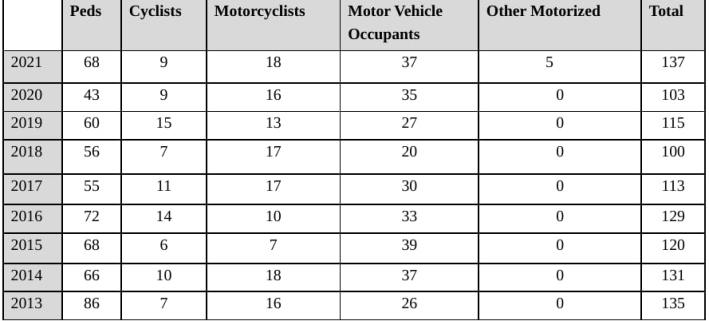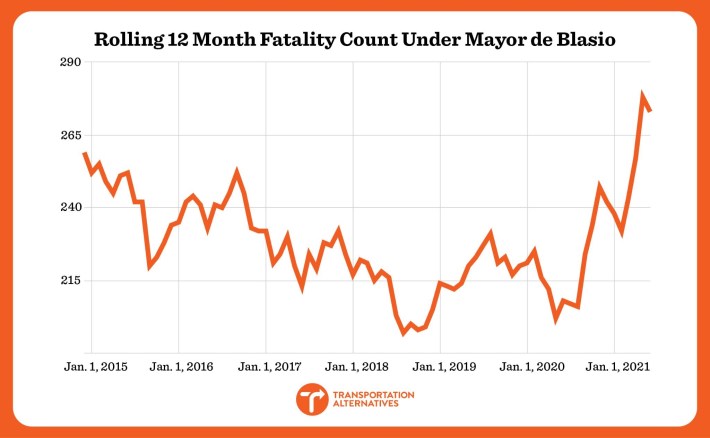New York City recently hit a dark milestone: This year is on track to be the deadliest for traffic fatalities since Mayor de Blasio took office. According to the Department of Transportation, as of July 19, at least 137 people have died because of motorists on city streets so far this year. It's the most fatalities since 2013, when 135 died in traffic violence over the same time period.

Pedestrian deaths are surging — 68 this year, compared to 43 at this point in 2020, a jump of nearly 60 percent. May was especially deadly. According to an analysis by Transportation Alternatives, Brooklyn, Queens and the Bronx all broke or tied fatality records that month. More than 1,700 New Yorkers have been killed by drivers since de Blasio took office in 2014, the same year he instituted Vision Zero. Traffic deaths steadily dropped, though pedestrian deaths began to tick up again in 2017. In mid-2020, traffic fatalities began a steep rise, fueled by reckless drivers who speed down roads that have yet to be calmed with appropriate infrastructure.
"More people are dying on Mayor de Blasio's streets because he failed to quickly and aggressively scale the safety solutions of Vision Zero that he knows work, instead choosing to deliver piecemeal projects and unfulfilled promises," Danny Harris, TA's executive director, said in a release.

The Mayor's Office points to the record number of bike and bus lanes the administration installed last year, its commitment to lower speed limits, speed cameras, and planned traffic-calming measures, and the "permanent" Open Streets program as evidence that it is taking the rise in fatalities seriously. In interviews and press conferences, the mayor blames the pandemic. "COVID unglued everything," de Blasio told WNYC's Brian Lehrer earlier this month. "We've seen really horrible trends since COVID began with these crashes and deaths. We will reverse it."
Yet the mayor must act much more aggressively to keep his own promises before he leaves office. In May, de Blasio said the DOT would install 28 miles of new bus lanes and create five new bike boulevards, one in each borough. Just three of those boulevards exist on the DOT's website (Jackson Ave and 39th Ave and Netherland Ave). Both note that "outreach/implementation" will happen in the fall. The DOT told Streetsblog that they have completed 1.25 miles of those bus lanes this year, including the two busways on Main Street in Flushing and 181st Street in Washington Heights, and a bus lane on Battery Place. The DOT reiterated the mayor's pledge to complete all the bike boulevards this year.
Concentration of wildfire smoke in the low levels of the atmosphere is creating low visibility and terrible air quality in NYC this afternoon. Here's an image of the NYC skyline just a few moments ago via @EarthCam. pic.twitter.com/goZkfkeqUH
— New York Metro Weather (@nymetrowx) July 20, 2021
- The smoke from Oregon's wildfires that blanketed New York City and prompted air quality warnings on Monday and Tuesday will have dissipated by now, we hope. If not, get used to it.
- de Blasio brandished a faux novelty check with the "$15 billion" that congestion pricing is supposed to raise in an effort to force the MTA, Gov. Cuomo, and the federal government to move forward with all deliberate speed. But if you were looking for him to do something to encourage New Yorkers to stop driving or use the power he wields over the streets to cut down on traffic, you were disappointed. The Post has coverage.
Hey @NYPD66Pct What do you intend to do about this behavior!? This just happened on Ocean Pkwy & Cortelyou. It’s happening all the time now.
— Antonio M. Rosario (@amrosario) July 20, 2021
( @bradlander @brooklynpaper @NYDailyNews @nypost @NYTMetro @NY1 @News12BK ) pic.twitter.com/OkNh5Ik10V
- Greg Knapp, an assistant coach for the New York Jets, was riding his bike in San Ramon, Calif., when he was struck by a driver, the Post reports. Knapp is in serious condition, and no arrests have been made.
- A report issued by the consulting firm McKinsey and a group of climate-minded cities notes that we need to be on a "wartime footing" when it comes to addressing the glut of wildfires and floods and sea-level rise and other catastrophes caused by global heating. Bloomberg CityLab has more.
- State Sen. Liz Krueger introduced a bill that would make leaving the scene of a crash a felony for cyclists and e-bike/e-scooter riders, matching the penalty for motorists. The Post's David Meyer has the scoop.
- The Brooklyn Bridge bike lane has almost reached Manhattan!
There ye unloads!!! The Brooklyn Bridge's #bikenyc lane barriers have made it to the Island of Manhattan!!! How many more months till we can ride on it?
— noel hidalgo • 🗽❤️🔥🚲 (@noneck) July 20, 2021
cc @StreetsblogNYC pic.twitter.com/mv6WKqOLf4
This story has been updated to reflect the DOT's response to our questions about bus lanes and bike boulevards.






